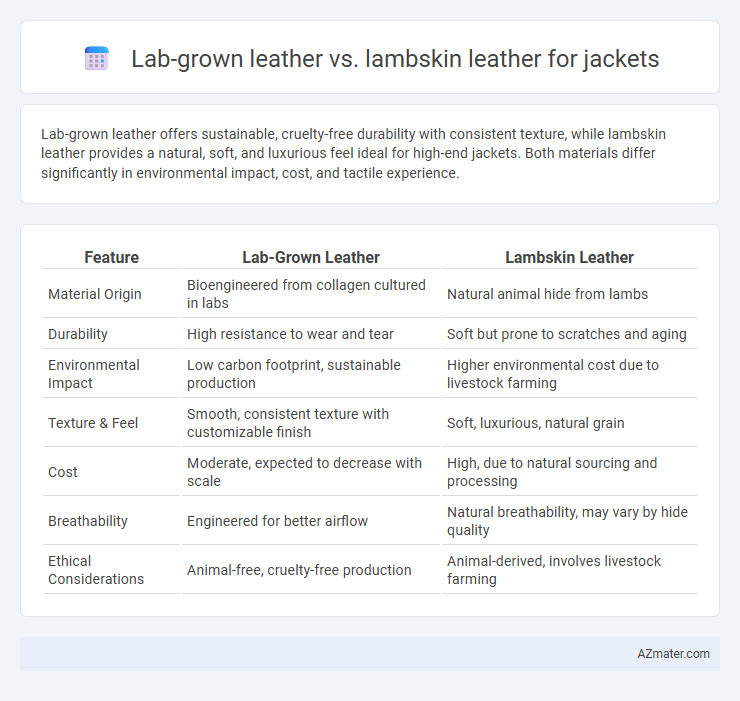Lab-grown leather offers sustainable, cruelty-free durability with consistent texture, while lambskin leather provides a natural, soft, and luxurious feel ideal for high-end jackets. Both materials differ significantly in environmental impact, cost, and tactile experience.
Table of Comparison
| Feature | Lab-Grown Leather | Lambskin Leather |
|---|---|---|
| Material Origin | Bioengineered from collagen cultured in labs | Natural animal hide from lambs |
| Durability | High resistance to wear and tear | Soft but prone to scratches and aging |
| Environmental Impact | Low carbon footprint, sustainable production | Higher environmental cost due to livestock farming |
| Texture & Feel | Smooth, consistent texture with customizable finish | Soft, luxurious, natural grain |
| Cost | Moderate, expected to decrease with scale | High, due to natural sourcing and processing |
| Breathability | Engineered for better airflow | Natural breathability, may vary by hide quality |
| Ethical Considerations | Animal-free, cruelty-free production | Animal-derived, involves livestock farming |
Introduction to Lab-Grown and Lambskin Leather
Lab-grown leather is a sustainable alternative created from cultured animal cells, offering a cruelty-free and environmentally friendly option for jackets. Lambskin leather, derived from the hides of young sheep, is prized for its softness, durability, and natural texture, making it a traditional choice in high-quality outerwear. Comparing these materials involves assessing factors such as environmental impact, tactile qualities, and ethical considerations.
What is Lab-Grown Leather?
Lab-grown leather, also known as cultured or bio-fabricated leather, is produced by cultivating animal cells in a controlled environment, eliminating the need for traditional livestock farming. This innovative method significantly reduces environmental impact, including water usage, greenhouse gas emissions, and land degradation compared to conventional lambskin leather. Lab-grown leather retains the texture, durability, and aesthetic appeal of lambskin while offering a sustainable and ethical alternative for jacket manufacturing.
Characteristics of Lambskin Leather
Lambskin leather is prized for its ultra-soft texture, lightweight feel, and natural breathability, making it a preferred material for high-end jackets. Its delicate grain provides a smooth, supple surface that molds comfortably to the body, offering both flexibility and durability. While lambskin leather develops a unique patina over time, enhancing its luxurious appeal, it requires careful maintenance to preserve its softness and prevent damage from moisture and abrasion.
Production Processes Compared
Lab-grown leather is produced through cellular agriculture, where animal cells are cultured in a lab environment to grow leather without raising livestock, significantly reducing environmental impact and resource use. Lambskin leather involves traditional tanning methods, where the hide of young sheep undergoes chemical and mechanical processing to create a soft, durable material with natural texture variations. While lab-grown leather offers consistency and sustainability, lambskin leather provides a natural grain and characteristic breathability valued in high-end jackets.
Environmental Impact: Which is Greener?
Lab-grown leather significantly reduces environmental impact by using fewer natural resources and producing less greenhouse gas emissions compared to traditional lambskin leather, which involves livestock farming associated with deforestation, methane emissions, and high water consumption. The biotechnological process of lab-grown leather eliminates the need for animal farming and toxic tanning chemicals, promoting sustainability and minimizing pollution. Lambskin leather, although biodegradable, requires extensive land use and energy input, making lab-grown leather a greener alternative for eco-conscious jacket production.
Durability and Longevity
Lab-grown leather offers superior durability and resistance to wear compared to traditional lambskin leather, making it ideal for long-lasting jackets. Lambskin leather, prized for its softness and natural sheen, tends to be more susceptible to scratches and environmental damage, potentially reducing the jacket's lifespan. Advances in lab-grown leather technology enhance tear resistance and moisture repellent properties, contributing to increased longevity in outerwear applications.
Comfort and Texture Differences
Lab-grown leather offers a consistent texture and breathable comfort, mimicking natural fibers while reducing animal cruelty. Lambskin leather boasts unparalleled softness and suppleness, providing a luxurious feel that molds to the body over time. The natural grain and elasticity of lambskin contribute to superior comfort, whereas lab-grown leather emphasizes uniformity and durability in jacket construction.
Style and Aesthetic Appeal
Lab-grown leather offers a sleek, uniform texture that appeals to modern, eco-conscious fashion enthusiasts, maintaining high quality with fewer imperfections than lambskin leather. Lambskin leather, prized for its natural softness and distinct grain variations, provides a luxurious and timeless aesthetic that enhances the sophistication of jackets. Both materials excel in style, but lambskin leather's classic appeal contrasts with lab-grown leather's innovative, sustainable edge, catering to different fashion preferences.
Price Comparison and Market Trends
Lab-grown leather offers a cost-effective alternative to traditional lambskin leather, with prices typically 20-40% lower due to reduced raw material and processing expenses. Market trends indicate a growing demand for sustainable and cruelty-free materials, accelerating investments in lab-grown leather technologies and expanding its availability in fashion sectors. Lambskin leather remains a premium choice with higher price points influenced by scarcity and artisanal production, but lab-grown options are rapidly gaining market share among eco-conscious consumers.
Which Leather is Right for Your Jacket?
Lab-grown leather offers a sustainable and cruelty-free alternative to traditional lambskin leather, providing similar softness and durability for jacket making. Lambskin leather is prized for its natural texture, breathability, and luxurious feel, ideal for high-end, classic jacket designs. Choosing the right leather depends on your preference for environmental impact, budget, and the desired aesthetic and longevity of your jacket.

Infographic: Lab-grown leather vs Lambskin leather for Jacket
 azmater.com
azmater.com